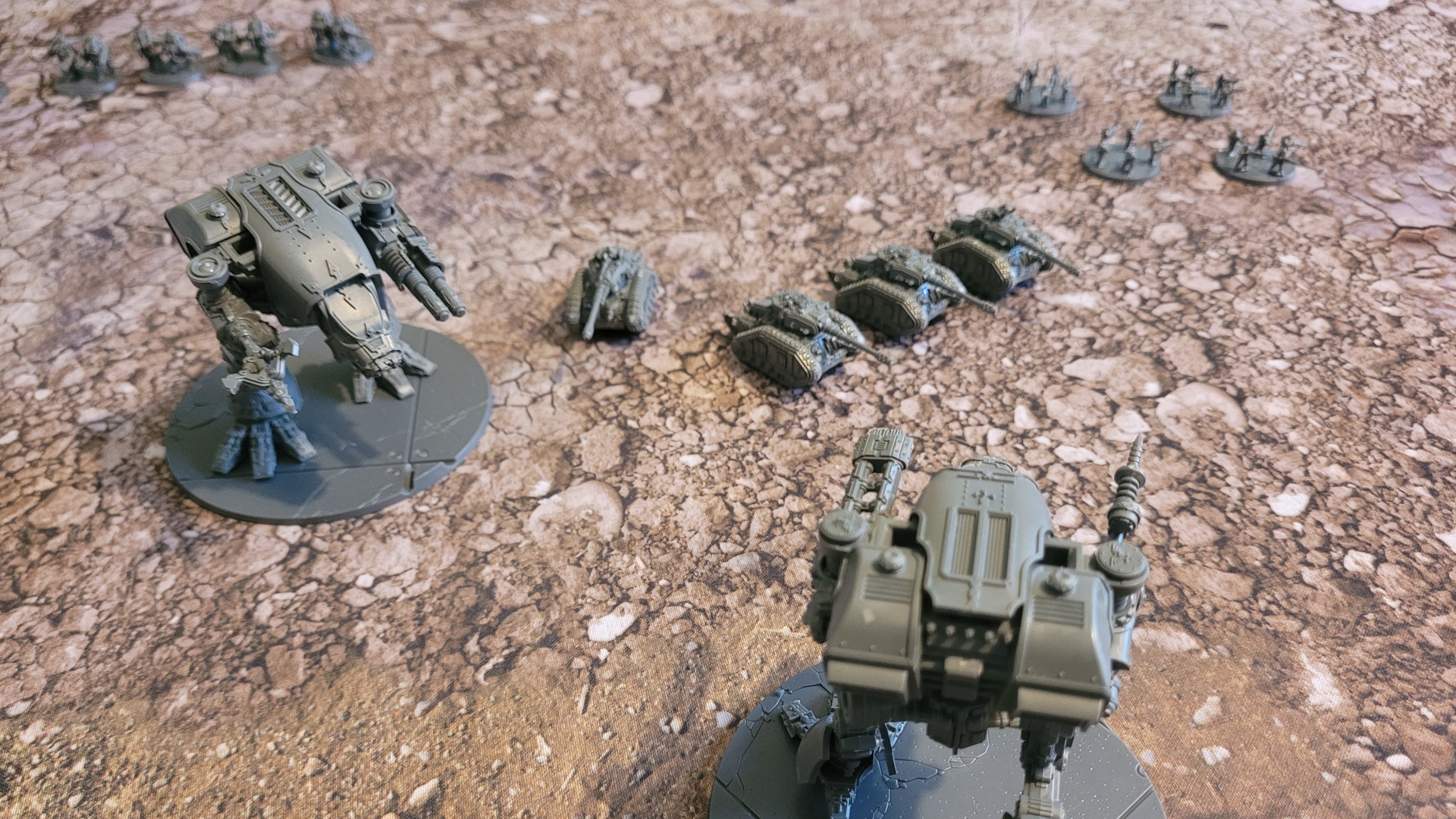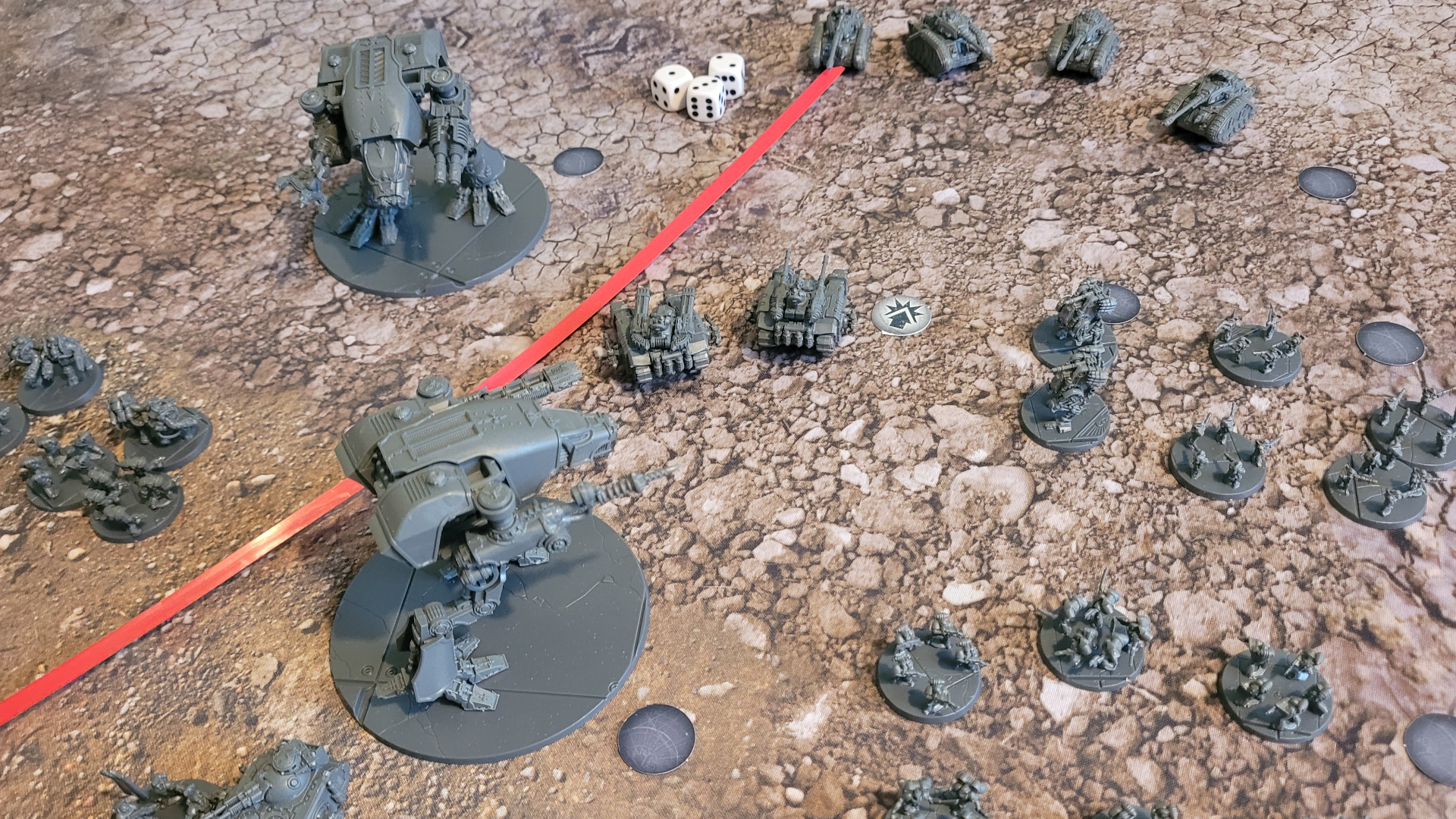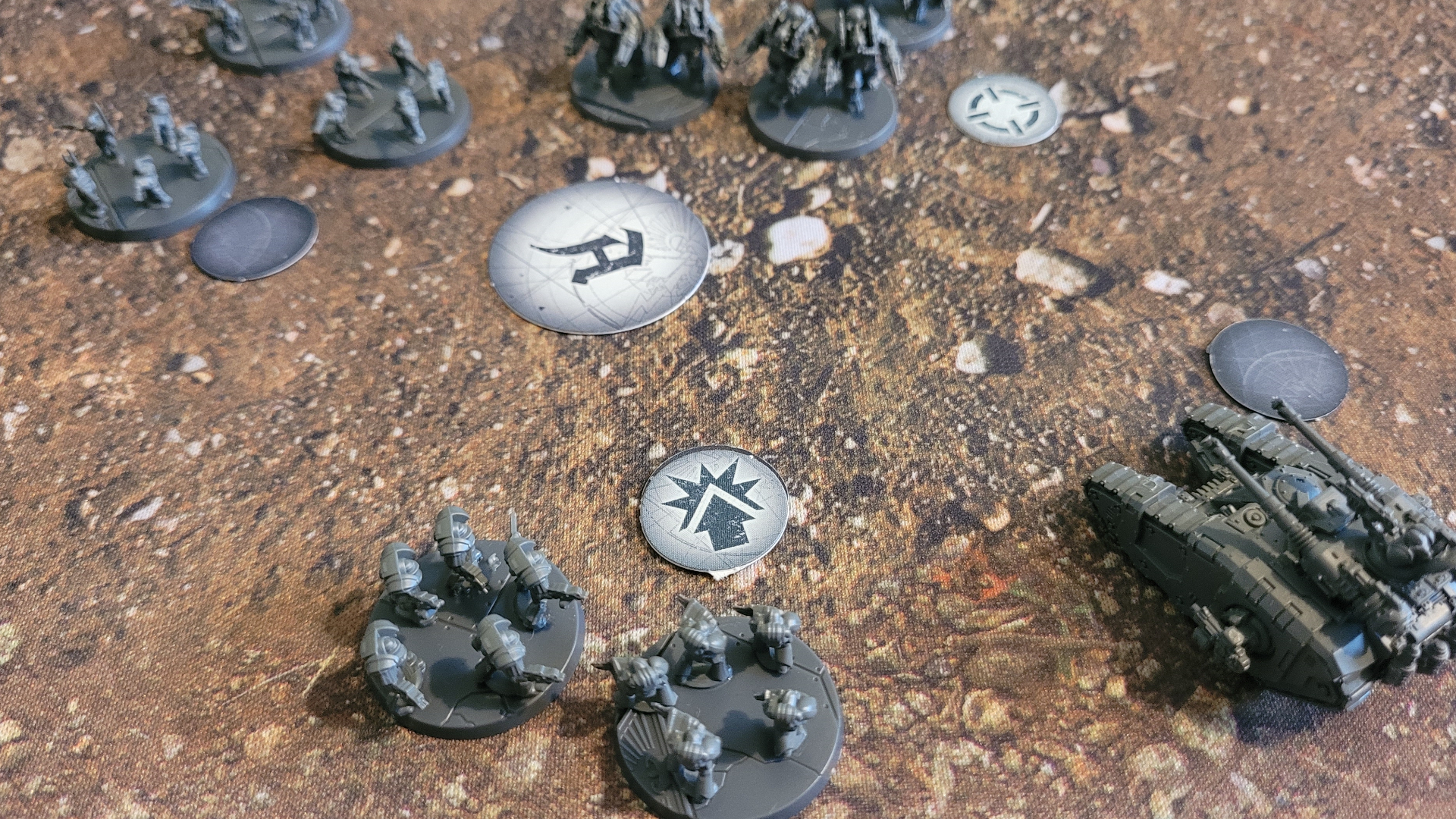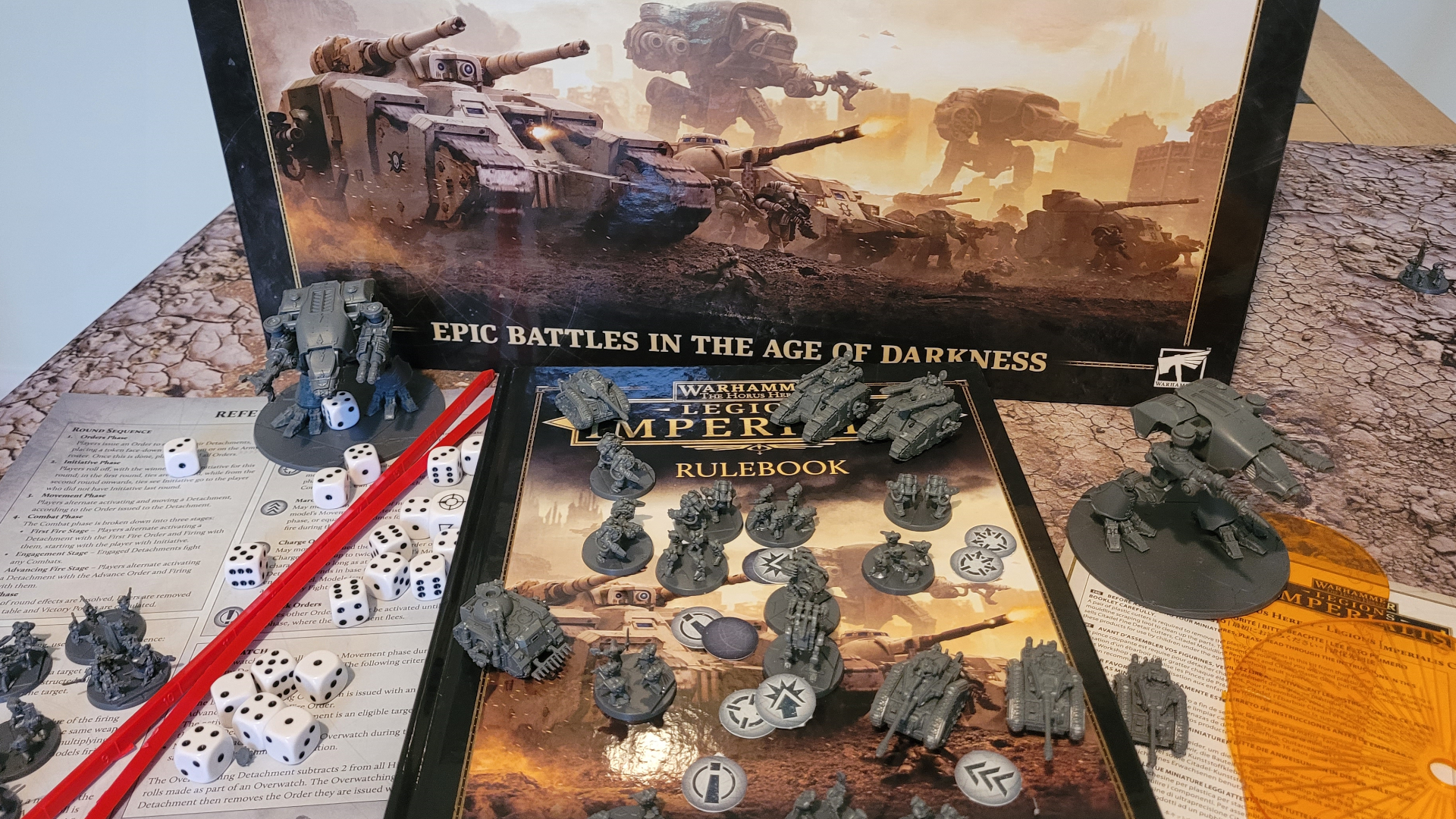GamesRadar+ Verdict
The Legions Imperialis starter set is an enticing look into a wargame unlike anything else on the market right now; although its depth can be intimidating and matches sometimes swing on a dime due to bad dice rolls, its emphasis on hidden moves makes for a compelling, white-knuckle match. Plus, the sense of scale and spectacle alone makes it worthwhile. However, even though this beginner box gives you a vast host of models and pretty much everything else you need to play, the fact that you have to buy more miniatures for 'full' games is slightly frustrating.
Pros
- +
A new system that has all the classic features plus some new twists
- +
Brings together figures from a number of other games into one combined whole that feels surprisingly realistic
- +
Impressive scale, which looks great on the table and lets you play enormous battles
Cons
- -
Combat resolution is dice-heavy and games can be very swingy
- -
Small scale miniatures are incredibly fiddly to build
- -
Poor selection of starter set contents that barely leave you with a legal army
Why you can trust GamesRadar+
The '80s Epic system still casts a long shadow, and you can feel it in this Legions Imperialis starter set. Besides being described as 'Epic Scale' (which isn't entirely true, because the original models are smaller), it's a clear love-letter to games like Space Marine and Epic 40,000. Crunchy, tactical, and staggering in scope, it's a glammed-up version of everything its predecessors wanted to be.
This is something fans have waited years for, and they'll almost certainly appreciate the result. But is the Legions Imperialis starter set a good place to kick things off for veterans and newcomers? Well, sort of. Although it gets you into the thick of a compelling (if swingy) game, there's some room for improvement with the box set itself.
Features & design
| Players | 2 |
| Ages | 12+ |
| Game type | Wargame |
| Genre | Sci-fi |
| Lasts | 120 - 180mins |
| Complexity | High |
- Vast armies on a tiny (Epic) scale
- Contains 223 miniatures
- Box set comes with core rulebook
This Legions Imperialis box is your standard starter set in all but name; it features the core rulebook, dice, range sticks, impact markers, and an impressive array of models that can be made into two distinct armies for use in a tiny theater of war.
There's a reason for that 'can.' I'm reviewing the Legions Imperialis starter set here, but as you might expect from Games Workshop, that’s just the tip of the iceberg… there are lots of additional miniatures you can buy to expand your army. And a good job too; each unit has a points cost and the rules recommend you field 3,000-point armies, but the total contents of both forces in the starter set comes to less than half that. It’s also worth noting that while the rules suggest you play with a field full of terrain to add strategic interest to battles, none of this is provided in the box. While that's not unusual in itself (plenty of Games Workshop products don't feature scenery), it is worth noting that you'll need to provide all of it yourself.

Worse, the only legal army you can field with the starter set totals about 350 points. To get around this, there’s a download from the Warhammer Community site – it’s not even in the box – with a special army build and scenario that lets two players face off against each other with half of the box's contents each. But this isn’t legal in most forms of play.
Either way, prospective players should understand that this box leaves them a lot of purchases away from a full force.
Anyway, let's pivot and talk about those miniatures for a moment. Fundamentally, you don’t play any Games Workshop title for the gameplay alone – you play it for the miniatures and the spectacle. In terms of the former, this is a mixed bag. The Titans look as spectacular as ever and the tiny tanks are a marvel of miniaturization, but I feel that the infantry are lacking in detail and character and everything is a nightmare of microscopic fiddliness to build (though I appreciate not everyone agrees – our Tabletop & Merch Editor, Benjamin, is rather taken with the infantry sculpts).
Once it’s on the table, the sheer scale of the thing is incredibly impressive
But once it’s on the table, the sheer scale of the thing is incredibly impressive, bringing home the vast proportions of Titans as they stalk through ruined buildings and step over, or on, the multitude of fierce battles for objectives unfolding beneath them.
It’s worth noting that Legions Imperialis is not an extension of either Adeptus Titanicus nor Aeronautica Imperialis, though, even if the models from those games are fully usable here. Rather, it’s a mechanically distinct game in its own right. So players familiar with those systems will have some un-learning to do.
Gameplay

- Hidden order system rewards forward-thinking and good second-guessing
- Huge power differentials between units make strategy both interesting and problematic
- All your hard work can be, and often is, undone by the dice
As you might expect from Games Workshop, Legions Imperialis is a pretty complex game. The core rules aren’t that long and the flow of each turn is simple enough to grasp, but there’s a lot of devilry in the details. Each unit has multiple weapon options, each with its own special rules that sit on top of the unit’s own bonuses and, in some cases, special rules for the faction as a whole. This takes a while to get your head around, and your first few games are likely to be pretty slow.
However, once you get into the swing of things, you'll be able to appreciate what it's going for. Each turn starts with players secretly assigning order tokens face-down to all their units, and those hidden orders offer what feels like a more realistic take on the chaos of battle. Armies can be unwieldy, especially in the heat of the moment, and that's represented well here.
This translates into fraught choices from setup onwards
Most Games Workshop titles have a core feel to the strategy and tactics which revolves around predicting range and a rock-paper-scissors hierarchy of certain unit types doing better against others, and that’s very much a part of Legions Imperialis. In this instance, it's reflected in the weapon options on most units. Sicarian tanks, for example, can be fitted with a main weapon that’s good against armor and flying units, or one that’s more of a jack-of-all-trades. Their side weapons are a choice between anti-infantry or anti-armour.
On the battlefield, this translates into fraught choices from setup onwards, as you try to place and then steer your troops opposite targets they can squish with impunity. Of course, your opponent is trying to do exactly the same, and from this comes much of the game’s tactical maneuver. However, this is where Legions Imperialis begins to differentiate itself from its peers. With literally much smaller units, there’s a lot more scope for interesting planning and movement before troops get within range of each other.
This is enriched by the hidden order system, which is very much a double-edged sword. Having to make order selections without knowing what your opponent is doing means players are well rewarded for second-guessing their opponent and getting it right. But it also means they can leave units stranded uselessly if they get it wrong. Picking the right order of activation for your troops is critical. Some gamers absolutely love these kinds of mind games and some loathe them, but there’s no denying that it lends the game a delicious frisson of tension.

The rock-paper-scissors aspect of strategy is likewise pushed to extremes by the range of units scales on offer. Paltry infantry units can’t be expected to make a scratch on a mighty Titan after all, and rightly so. So if you end up in unequal confrontations, it can go south with spectacular speed. At the same time, melee can be a great leveler. A Kratos super-heavy tank still only rolls the same two dice in close combat as a base of Terminator marines, but with a lower close assault bonus. And again, rightly so; a tank swarmed by infantry is a sitting duck.
Add in the buckets of dice rolled in shooting and armor saving, and you’ve got a game that rewards planning and reading your opponent, but often swings wildly on random dice rolls or miscalculated maneuvers. There’s also a lack of balance in the faction abilities, with some clearly being better than others.
It is, again, a typical Games Workshop affair, but one that has enough extra bells and whistles to distinguish it, make it feel unique. Not least in the fact that, by excluding the wilder aspects of the 40K universe like aliens and psychic powers, it feels more like a traditional force-on-force combined arms wargame.
Should you buy the Legions Imperialis starter set?

Whether the Legions Imperialis starter set is for you hinges on several key questions. Firstly, are you prepared to spend a lot more, in terms of both time and money, buying, assembling and painting additional figures? All those things are essential to getting the most out of the system and, while the starter set is relatively good value, it’s a very poor selection to start an army with.
Second, how do you feel about Games Workshop systems in general? This is new, but it isn’t a radical departure. So if you’re already a fan, you might not have space in your life for another system and if you’re not, there may not be enough here to tempt you in. But what is wholly novel is the sheer scale and spectacle on offer here. Legion Imperialis looks like nothing else in mainstream gaming, and its grand sense of epic warfare is fulfilling in and of itself, whatever you make the gameplay.
Buy it if...
✅ You want to see truly massive battles in the 40K universe unfold on your table
Because there are countless miniatures on the board, Legions Imperialis truly sells the scale of war we normally only see on-screen or in artwork.
✅ You like the idea of a sci-fi miniatures game that feels vaguely realistic
Because there aren't magical psykers or alien forces, this feels a lot more down-to-earth than normal Warhammer (if you can ignore the giant mechs, anyway). That's a refreshing change of pace.
Don't buy it if...
❌ You’re not willing to make significant further investment in figures and terrain
Because Legions is at its best with a larger force, you'll need to buy more units and terrain. The overall investment will obviously rise quite sharply as a result.
❌ You don’t like long, complex games that are prone to random swings
You are still beholden to the roll of the dice with this one, so bear that in mind if randomness annoys you.
How we tested the Legions Imperialis starter set
This review unit was provided by the publisher.
After spending time combing through the rulebook and piecing together every unit, I played sessions of the game using the Legions Imperialis starter set to get a sense of how it worked in action.
For more on our process, see the GamesRadar+ Hardware Policy.
Want more recommendations? Be sure to check out our guide to the best board games.
More info
| Genre | Wargame |
Matt is a freelance writer specialising in board games and tabletop. With over a decade of reviews under his belt, he has racked up credits including IGN, Dicebreaker, T3, and The Guardian.




